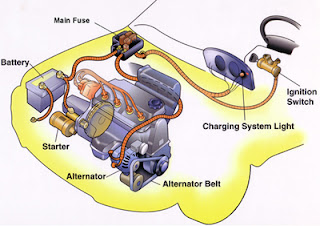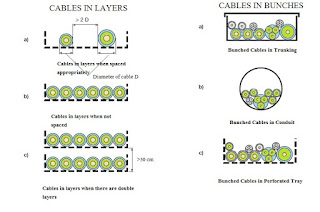Alternator in Cars
Alternators are used in cars to generate current for running of cars. We
quite often get confused that why alternator is required when there is battery
available in cars.
Battery in cars is only used for starting the cars, but for lights
operation and functioning of other parts current is required now from where
that power will come???
For fulfilling the above purpose alternator is required, alternator has
following functions in cars:-
(i)
Running of lights, heater, Air conditioners and operation of other
electrical accessories
(ii)
Recharging of battery as it get discharged during starting.
Now how this alternator works in cars and who provides mechanical power
to alternator so that power output can be generated at alternator output??
When you switched off your car engine than radio of car will work on car
battery. For engines running following are required:-
(i)
Air
(ii)
Fuel
(iii)
Spark
Last part is supplied by alternator because spark is generated through
electricity, although battery is
available for supplying the spark but not for keep running the car. Battery
electricity is sufficient for keep running the vehicle for few KMs but vehicle required much more than that , so to serve the purpose
alternator will comes into picture.
Alternator in vehicle has output of 13.5 - 14.8 volts.
In past generators were used in cars, these generators are very
inefficient in comparison to alternators, also at that time charging of battery
and keeping accessories lighting up was different from present scenario. There
are following components of alternators:-
(i)
Stator
(ii)
Rotor
(iii)
Voltage regulator you can also say automatic voltage regulator
(iv)
Direct current circuitry consisting of diodes
Now with rotation of rotor electricity get generated and output is used
for charging batteries and keeping the auxiliaries ON.
DC circuitry is used to convert the alternating current generated by
alternator to DC. Voltage regulator is used to keeping the voltage generated by
alternator within limits. Feedback is
received by voltage regulator and accordingly output gets controlled. Now day’s voltage regulators are integral
part of alternators. But in past voltage regulators were big boxes and they
were kept in hood and wired into the system. Voltage regulator functions are as
below:-
(a) Cut off the power to battery when
battery get fully charged i.e. when battery voltage reached certain level
around 14.0-14.5 volts
(b) To keep voltage level within limits as
per requirement of auxiliaries.
How to get noticed that
Alternator is faulty??
It can be easily detected as you will observe reduced illumination from
head lights , sometimes reduced illumination may not get detected while driving
as during that time battery will provide necessary electricity . But as battery
power get used for illumination of headlights now when you tried again to restart
the vehicle then vehicle doesn’t start as battery get drained up.
Starting current of a car:-
When you tried to start a car your battery should be strong enough to provide crank to engines so that car get started easily. You may often see that very heavy leads are connected at battery terminals as starting current is very heavy for starting the car. By Ohms law we know that Voltage = Current X Resistance and now Voltage of battery is 12 V and starter motor resistance is approximately 0.12 Ohm so

